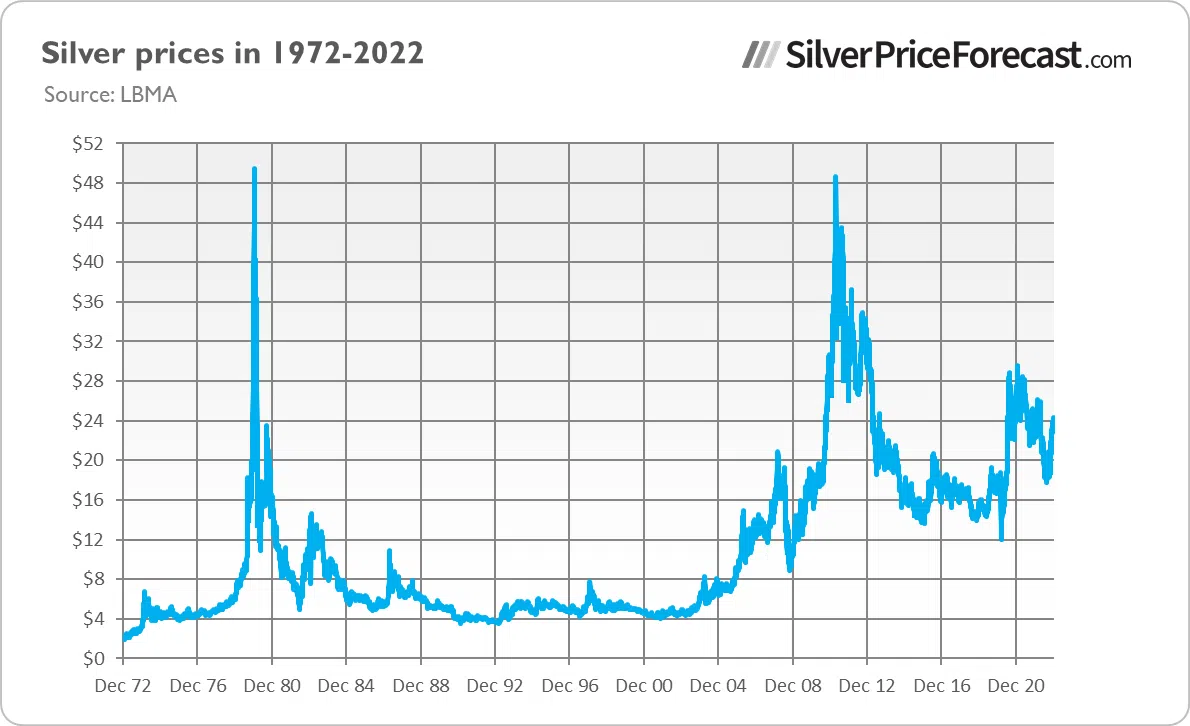Should You Buy Silver for the Long Run?
While silver generally goes up in the long term, its performance in the last 50 years is far from impressive.
Earlier this week, I wrote about the long-term performance of gold. But what about silver? Let’s find out! Unfortunately, I didn’t find data going back to the 19th century, so we must be content with the price series beginning in 1968. As one can see in the chart below (courtesy of silverpriceforecast.com), the price of silver increased from $2 to about $24 at the end of 2022. It implies a stunning 1079% rate of return or a tenfold increase!

However, on an annual basis, it translated into a geometrical rate of return of just 5.06%. What’s more, it’s a nominal rate of return; in real terms it drops to just 0.61%. It’s positive, so silver keeps its purchasing power, but the number is rather disappointing.
Please note that even these numbers could be somewhat overestimated, as silver prices were boosted in the 1970s by the end of the gold standard and the resulting turbulence in the global economy. The thing is that it was a unique event that won’t happen again.
What Does It Mean for Silver as an Investment Asset?
The obvious implication is that silver shouldn’t be purchased as a long-term engine of growth but as an investment portfolio diversifier or insurance for the remainder of your investment portfolio, and, to some extent, the safe-haven asset.
Stocks should be the growth engine of each investment portfolio. They should outperform commodities in the long run. Actually, if shares of productive companies rose less than silver rocks, it would be a bad symptom.
In other words, when you buy silver, you could expect a small but positive real rate of return, so it will keep pace with inflation and add something more. However, gold performs here better with its annual geometrical nominal of returns and real rate of returns - respectively, of 6.9% and 2.8%.
Silver’s attractiveness lies somewhere else. You can invest in silver in order to benefit from the cycles in the precious metals market. It’s more volatile than gold, so it’s a better asset for speculation. As you can see in the chart above, silver prices skyrocketed above $48 in early 1980, and later it repeated this achievement in 2011, in the aftermath of the Great Recession. Thus, if you time the wave, you could earn a lot. This leads us to the next section.
Implications for Silver
What does is all mean for the silver (and gold) outlook for 2023? Well, silver has been in an upward trend since November 2022, as the chart below shows (courtesy of silverpriceforecast.com).

And given a significant global macroeconomic reset and the eventual Fed’s pivot, silver bulls should dominate the marketplace in the upcoming months. Or at least the recession fears and expectations of a more dovish monetary policy should provide a tailwind forsilver prices.
Arkadiusz Sieron, PhD